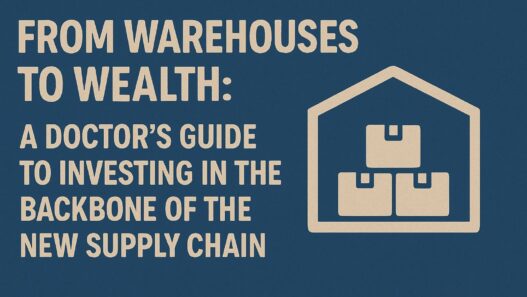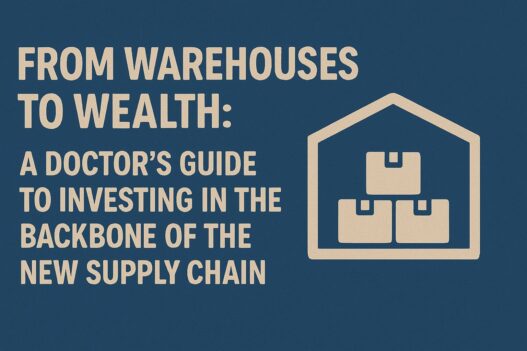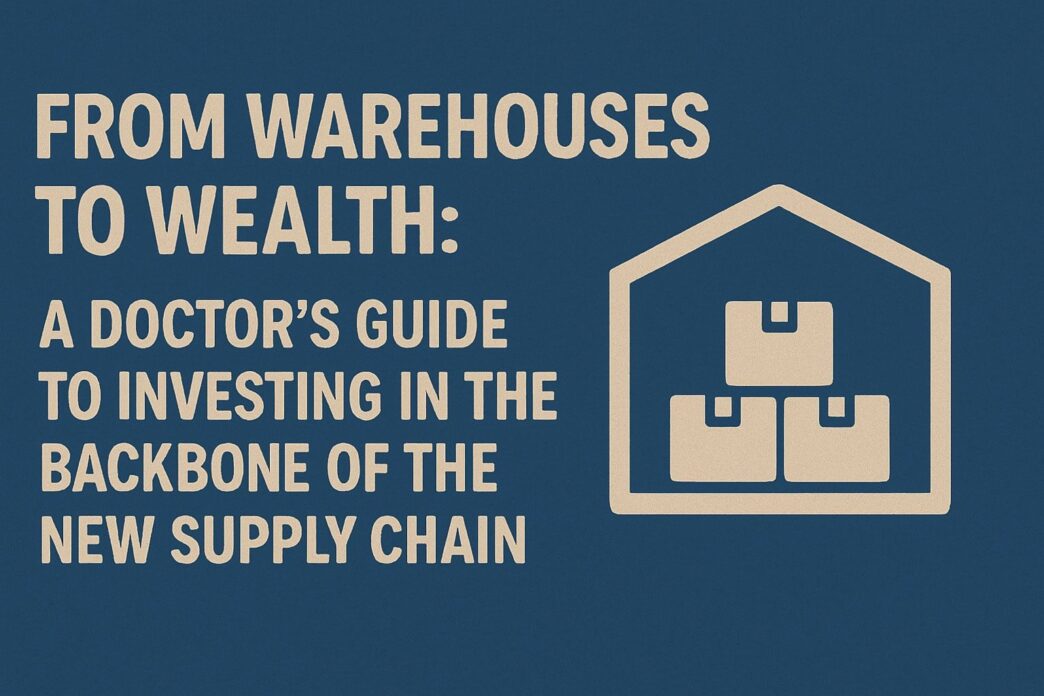Why Doctors Are Looking Beyond Apartments
Many physicians who discovered passive income through multifamily syndications over the last decade are now looking elsewhere. Cap rates compressed, reducing long-term appreciation potential and near-term cash flow. Yields thinned. And new supply is weighing on rent growth in many Sun Belt markets. Physicians have had plenty of exposure to multifamily through real estate crowdfunding platforms and syndications over the past decade. Given current market dynamics, industrial may be the next frontier for self-directed investors, especially those who prioritize stable, robust cash flow.
Warehouses, logistics centers, and light-manufacturing facilities are benefiting from two megatrends shaping the U.S. economy: the e-commerce revolution and the reshoring of American manufacturing and supply chains.
According to Green Street and Newmark's 2025 industrial outlooks, national industrial occupancy remains near record highs at roughly 93%, and rents have increased more than 40% since 2019. Even as new construction slows, demand continues to outpace supply, especially in infill “last-mile” and small-bay properties close to population centers.
For high-earning professionals looking for predictable income with inflation protection, that's a compelling macro thesis. That said, executing on industrial real estate investment takes particular skill and expertise – for passive LP investors, it's about finding the right manager and asking the right questions.
How the New Supply Chain Is Re-Wiring America
Reshoring, e-commerce, and automation are reshaping where companies operate—and where investors should look for durable return potential.
After decades of globalization, the pandemic and recent tariff shocks revealed just how fragile long supply chains can be. In response, companies from Intel and BMW to Ford and Toyota are investing billions to bring production back to U.S. soil.
While the current policy environment supports ongoing reshoring, the trend has been underway for some time. The Reshoring Initiative reports that more than 244,000 manufacturing jobs were created in 2024 alone and over 1.7 million since 2010, with half of those arriving in just the past five years. Every new manufacturing hub triggers layers of logistics demand—suppliers, packaging, cold storage, and regional distribution—creating a ripple effect of warehouse absorption. Given the priorities of the current administration and recent survey data, this dynamic seems poised to accelerate in the coming years.
Markets like Dallas–Fort Worth, Greenville-Spartanburg, Columbus, and Louisville have become magnets for these ecosystems. Newmark data shows that even with vacancy creeping above 7% nationally, shallow-bay infill assets (sub-100,000 sq. ft.) still average 4–5% vacancy, underscoring their scarcity and resilience. (Infill assets are developments or repositionings within urban or suburban areas, strategically chosen for meeting tenant demand.)
In short, manufacturing's comeback is building the backbone of a new supply-chain economy—and investors can own the infrastructure supporting it.
Industrial Isn't One Thing: Know Your Subtypes
The word “warehouse” can mean many things and reflect various different investment profiles. Each subtype has a different tenant profile, lease structure, and risk-return trade-off.
Self-directed investors who understand multifamily fundamentals will find familiar logic here: location, tenant quality, and lease duration all determine yield stability. But the industrial landscape is more diverse than apartments by class or location. Here's how the main categories stack up:
- — Multi-tenant spaces leased to tradespeople and small distributors. Short, one- to three-year leases mean higher turnover but excellent rent growth. Vacancy nationally runs below 5%.
- Shallow Bay (20,000–100,000 SF) — The “sweet spot.” These suburban-infill assets serve regional distributors and light manufacturers. Cap rates typically sit between 6.0% and 6.5%, offering better risk-adjusted returns than large single-tenant facilities.
- Last Mile (10,000–50,000 SF) — In-town warehouses that put goods within minutes of consumers. Older specs, premium rents, and near-zero vacancy in major metros.
- Bulk Distribution (100,000–500,000 SF) — The big-box corridors along interstates or airports that move goods regionally. Longer leases (five to ten years) and strong credit tenants deliver stability but less upside.
- Specialized / Manufacturing — “Mission-critical” facilities for food logistics, pharma, or semiconductors. Long leases and sticky tenants, but high re-tenanting costs if vacated.
For diversification, sophisticated investors blend these subtypes—balancing shorter-term shallow-bay yield with the security of long-term credit leases in bulk or specialized assets.
Why Industrial's Income Profile Feels Different
Industrial leases are often triple-net (NNN)—meaning tenants pay taxes, insurance, and maintenance. That shifts operating-expense risk away from the owner and creates steadier cash flow.
In contrast to multifamily's monthly rent rolls and frequent turnover, industrial income streams are long-dated and contractual. Lease terms often run five to ten years, with annual escalations of 3% or more, helping investors keep pace with inflation. At a time when trade and tariff policy may keep upward pressure on prices, this should be an appealing characteristic for cashflow-minded investors.
Because tenants customize space—installing racking, automation lines, or refrigeration—they're reluctant to relocate, yielding retention rates above 80% at renewal in many internal Lightstone and Green Street datasets. The result: fewer surprises, lower CapEx, and potentially smoother cash-flow curves.
The Flip Side: Downside Scenarios
The other side of this coin: because tenants are corporate entities with complex needs, and property cash flow is generally dependent on a smaller number of tenants, vacancy risk may be amplified.
That said, a well-equipped, well-situated industrial asset may benefit from potential downside scenarios to mitigate risk – e.g., light capital improvements to reposition the asset for a different tenant base in accordance with the demand dynamics of the local economy. But it takes specialized, region-specific know-how to account for these risks and build in effective leasing plans and downside scenarios. Look to partner with GPs who have not just industrial experience, but experience executing within the specific sub-type of industrial asset, and experience in the region. Lightstone, for example, employs Acquisitions and Asset Management teams that are specialized in the industrial asset class.
Key Market Dynamics for 2025
- Supply Is Finally Slowing: After a record construction wave in 2022–2024, new industrial starts are down 30–40% year-over-year, tightening the pipeline.
- Rent Growth Is Outpacing Inflation: PGIM Real Estate notes that global industrial rent growth has averaged 5–7% annually since 2021, well above core CPI.
- Private Capital Is Pouring In: CBRE's 2025 Cap Rate Survey found that over 70% of investors now expect industrial yields to compress over the next six months—more than any other property type.
In short, industrial may offer a superior supply/demand balance versus many multifamily markets, especially versus Class A apartment development.
Comparing Industrial to Multifamily
For passive investors already exposed to multifamily, industrial may offer a compelling alternative and means of further diversification.
| Metric | Typical Multifamily Syndication | Industrial (Direct Sponsor) |
| Lease Duration | 12 months | 5–10 years |
| Tenant Credit | Individuals | Corporate/Institutional |
| Expense Structure | Landlord-heavy | Frequently Triple Net (Tenant Pays OpEx) |
| Rent Growth Mechanism | Market resets on turnover | Built-in annual escalations |
| Vacancy Volatility | Moderate | Low in infill and small-bay segments |
| Fee Stack | Often 3–4 layers (BD, Platform, GP) | Direct Sponsor – flat and transparent |
While effective multifamily investment relies more on constant re-leasing and operating efficiency, industrial investment execution relies more on credit underwriting and location selection. Both can perform—but industrial's longer leases and lighter expense load create an income profile that offers potential stability in a way that many types of multifamily currently cannot. Furthermore, the different leasing dynamics, time horizons, and demand drivers of industrial (versus multifamily) create a diversification opportunity for those who may be long on multifamily investments already.
Lightstone evaluates industrial deals across the country (along with multifamily and several other CRE asset classes). Among deals that make it to the investment committee, cap rates and cash flow potential vary by market, by asset, and by strategy. At a very general level, average cash-on-cash return potential tends to pencil out to 100-300 basis points higher for industrial deals in today's environment.
The Direct-Sponsor Advantage
Traditional crowdfunding platforms or non-traded REITs often insert multiple intermediaries—each potentially taking a fee slice before returns reach the investor. A direct-to-manager model can remove this fee drag and misalignment of interests.
For instance, Lightstone co-invests at least 20% of the equity in each single-asset industrial and multifamily deal on the Lightstone DIRECT platform alongside individual accredited investors. That alignment means the GP's capital is at stake next to yours, demonstrating conviction in the deal — this level of alignment is severely lacking among most real estate investment options for high-income professionals.
Why Industrial Deserves Allocation in a Physician Portfolio
Industrial real estate addresses a specific challenge for high-income professionals: finding stable cash flow that keeps pace with inflation while diversifying beyond saturated multifamily markets. The sector's fundamentals—long-term leases, corporate tenants, triple-net structures, and exposure to reshoring and e-commerce—align with what many physicians seek from passive investments.
The difference between theory and execution, however, comes down to operator selection. Industrial requires specialized expertise in credit underwriting, regional market dynamics, and asset-specific repositioning strategies. For passive limited partners, the sponsor matters as much as the asset class itself.
The Case for Direct Access
Most physicians encounter real estate through crowdfunding platforms or multi-layered syndications, where intermediaries add cost and complexity between investor and operator. Each layer—broker-dealer, platform, fund manager—extracts fees before returns reach the LP.
Direct-to-sponsor models eliminate this friction. Lightstone, an institutional operator managing $12 billion across commercial real estate, provides accredited investors with single-asset access through its Lightstone DIRECT platform. The firm's minimum 20% co-investment in every deal ensures the general partner's capital is at stake alongside investor capital—a level of alignment rarely found in traditional syndications.
For physicians evaluating industrial exposure, the relevant question isn't whether the asset class has merit. Market data from Green Street, CBRE, and Newmark supports the thesis. The question is whether you're working with operators who possess both specialized industrial expertise and the conviction to invest their own capital in each transaction.
Lightstone DIRECT offers institutional-quality industrial and multifamily deals typically available only to family offices and endowments. Explore current opportunities and sponsor track records at lightstonedirect.com.
(c) 2025 Lightstone Direct. Market data sources: Green Street, Newmark, CBRE, PGIM Real Estate, Reshoring Initiative. This article is for informational purposes only and does not constitute investment advice. Past performance does not guarantee future results. All real estate investments carry risk, including potential loss of principal.)












